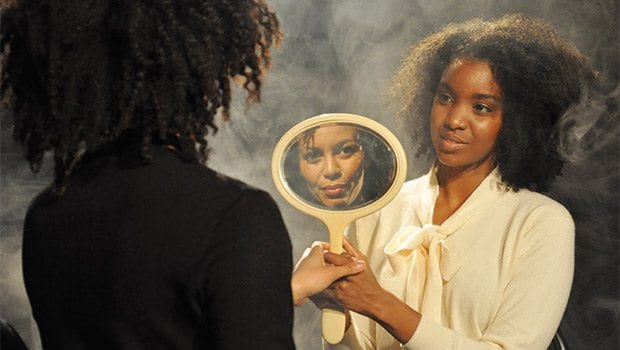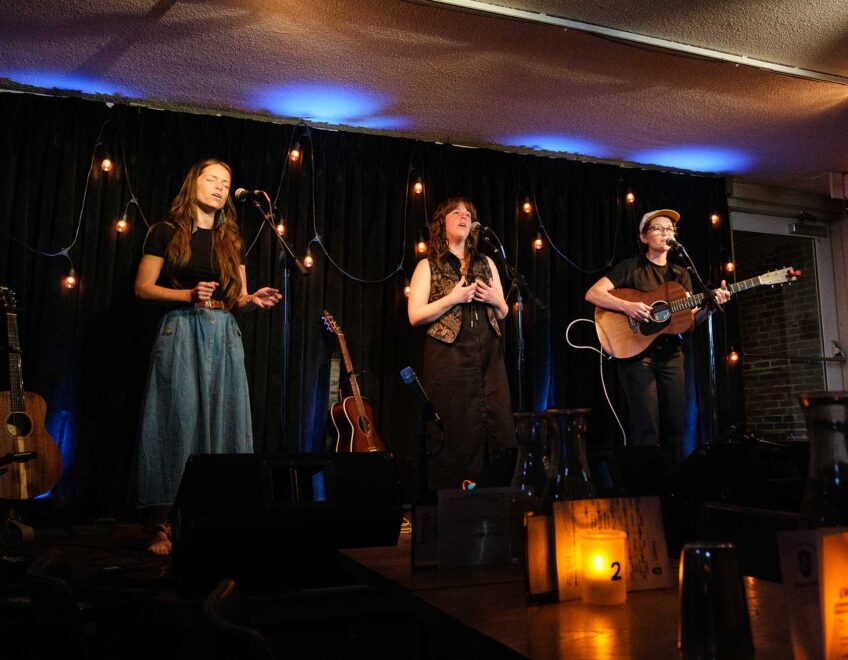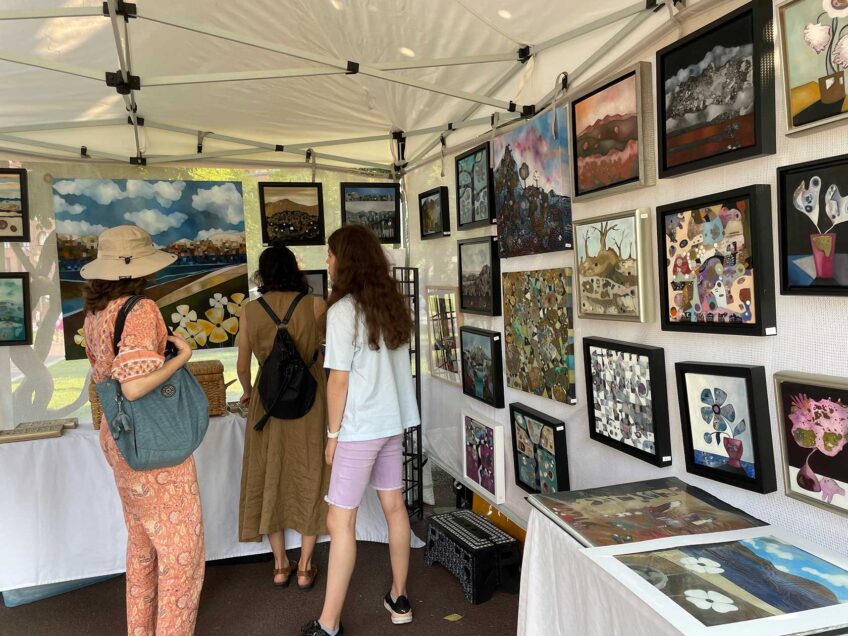The photos of Carrie Mae Weems are on display at the Ethelbert Cooper Gallery through Jan. 7

A good story can recast the familiar and reveal something new. Artist Carrie Mae Weems tells a good story. With text, photographs and videos, she recasts the familiar into new stories in which people excluded from power claim their ground.

Author: Photo: Courtesy of the artist and Jack Shainman Gallery, New York“The Louvre – Paris” by Carrie Mae Weems (2006)
Often with humor, and almost always with beauty and style, Weems investigates and asserts power on the home front, in the art world, and in society at large. Some works are as joyful and empowering as folk tales. Others are scathing correctives. Coursing through all is a palpable sense of self-respect.
Also telling a good story is the exhibition of 52 works by Weems on view through Jan. 7 at Harvard’s Ethelbert Cooper Gallery of African and African American Art in Harvard Square. Entitled “Carrie Mae Weems: I once knew a girl,” the show presents works by Weems from the past two decades of her career. Curated by gallery director Vera Ingrid Grant in collaboration with Weems, the exhibition follows Weems as she asserts power through art.
As a photographer, Weems works mainly in black and white and frequently includes overlays of text in her prints. The show begins with six images from her 1997 series, “Not Manet’s Type,” including one that is a sort of manifesto. While posing as a nude, she declares herself unsuited to this traditional female role in western art and states, “I knew, not from memory, but from hope, that there were other models by which to live.”
As if in response, prints on the opposite wall, from her series “Slow Fade to Black” (2009-11), show blurred figures of performing artists Josephine Baker, Lena Horne and Katherine Dunham.
With its black and white palette, her handsome imitation of a Jackson Pollock drip painting, “Splattered 1” (2016) is a sly insertion of race into the white male dominion of mid-century modernism. Nearby her silkscreen print, “Splattered 2” (2016), overlays a vintage photo of plantation-era black field workers with Pollock-style droplets of paint, mingling African American and art history.
A former dancer, Weems often performs in her photographs and videos, in which the figure of a woman is not an object of male interest but a subject taking charge of her own experience. In this, Weems is kin to Lorraine O’Grady, 82, who in images of wit and flair cast herself as a stylish party crasher challenging boundaries of gender, class and race. Another major artist exploring this terrain is Lorna Simpson, who uses models rather than inserting herself into the scene.
Identity and power
In the ’80s, while teaching at Hampshire College in Northampton, Weems developed her much admired “Kitchen Table Series” (1990), which has just been published in book form. Weems cast herself as the protagonist in this fictional narrative, which in photographs and text explores a woman’s relationships with her lover, friends and children as they mingle around the kitchen table.
Weems’ photograph, “The Considered, See Bergman” (2012), evokes the artist’s abiding interest in personal identity. While alluding to the 1966 movie “Persona,” Ingmar Bergman’s study of the female psyche through an anguished encounter between two women, this image shows a radiant woman (Weems) smiling into a mirror held by an admiring girl.
An artist whose works frequently bridge divides, Weems is captivated by primitive communication devices. On view here are her photographs of tin cans and a megaphone, which render their angles and curves in compositions of modernist simplicity.
In a novel tribute to civil rights activist and scholar W.E.B. Du Bois, Weems worked with botanists to name a peony in his honor. Her voluptuous portraits of the flower, one of few works on paper in color in the show, appear alongside photographs of a garden she envisions for Du Bois.
In contrast to these pastoral scenes is a searing trio of videos by Weems on view in the gallery’s media room. “History Repeating” (2016) alternates between a video of a breast-beating black congregation and news clips of recent police shootings. In “Comedy Updated” (2016), silhouetted figures of two plantation-era ladies that evoke Kara Walker’s stencils of clichéd characters of the Old South are seated for a genteel tea. While Weems, in voiceover, tells debasing racial jokes, her cartoon figures repeatedly double over in laughter. Most chilling of all is “The Obama Project” (2016), which distorts the president’s face to resemble all the villains and fools to which his enemies have compared him during his years in office.
On view in another gallery is the video “Afro Chic” (2009-10), in which Weems conjures an empowering, joyful fashion show. Sporting giant Afro wigs in a rainbow of sherbet colors, huge earrings, glossy painted lips and ‘60s disco garb brimming with brocade, glitter, fur and leather, an array of self-assured women strut down the runway with the sole purpose of pleasing themselves. Celebrity guests, present in the form of photographs, are Angela Davis and Huey Newton, stylish leaders of the Black Panther Party.
In wall-sized photos, Weems extends her investigations of power throughout the world. Her “Roaming” series shows her standing before imposing edifices in European capitals with her back to the camera. She wears a black dress that contrasts her womanly curves with the sharp geometric forms of the buildings, designed by male architects. In a video, the camera follows her black-garbed figure as she explores the gardens and towns of Italy, walking in a slow, elegant pace as if in a dream.
The exhibition’s earliest work, “The Shape of Things” (1993), is a photograph of a traditional stucco structure in Africa. In her close-up of the rounded orifices that are its windows and doors, the building resembles a woman’s abdomen.
Sharing the artist’s interest in power is the designer of the Cooper Gallery, David Adjaye, the Ghanaian-British lead architect of the National Museum of African American History and Culture in Washington, D.C. The new museum’s shimmering bronze façade evokes both the shape of an African crown and the metal of slave shackles.
Weems has received many awards, including a MacArthur “Genius” grant. Her works are collected by major museums throughout the world. In 2014, the Guggenheim Museum was the fifth and final venue for a 30-year retrospective of Weems that toured nationwide over two years.
Artistic spirit
Born in Portland, Oregon, Weems took up photography in her 20s while raising her young daughter and working as a community organizer. An early project, “Family Pictures and Stories” (1978), combined photos and recorded oral histories of her family, descendants of Southern sharecroppers. In 1981, she graduated from the California Institute of the Arts and in 1984 earned an MFA from the University of California at San Diego. She then spent three years studying folklore at UC Berkeley.
An artist whose practice extends beyond the studio, Weems lives with her husband Jeff Hoone in Syracuse, New York, where she has conducted youth art projects and a public art campaign against gun violence.
Weems includes in this show a selection of children’s art from a recent community project she led to celebrate the Obama family. The high-spirited display serves as an antidote to “The Obama Project,” which plays in the same room.
Here and throughout this exhibition, Weems is both an observer of her world and an agent of change.






